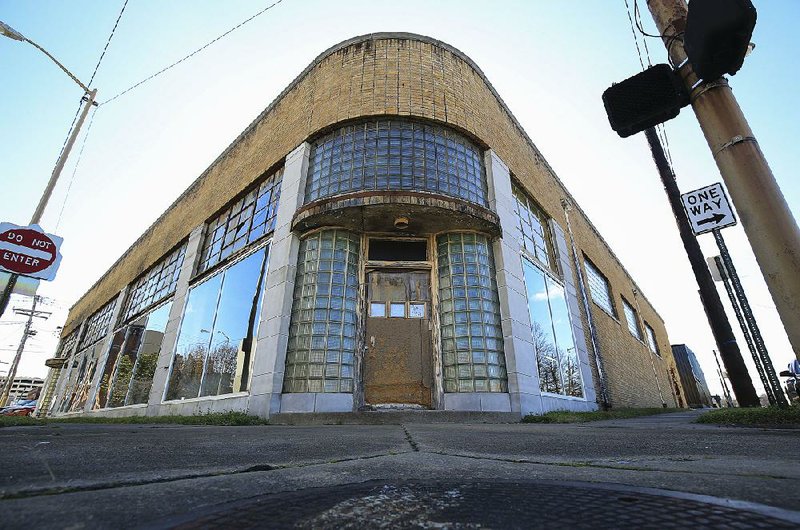Two filling stations, an automobile dealership and an auto parts store have been listed on the National Register of Historic Places along with a dozen other Arkansas properties.
The Arkansas Historic Preservation Program made the announcement Monday.
The new listings include a Gulf Oil Co. gas station in Stamps (Lafayette County) and a Magnolia Petroleum Co. filling station in Kingsland (Cleveland County). Both were constructed around 1930 to handle the increasing number of cars on Arkansas roads, according to the nomination forms.
"The automobile was becoming much more accessible and usable in Arkansas by the early 1930s," said Ralph Wilcox, the National Register and survey coordinator for the Arkansas preservation program. "This was partly due to a tremendous effort to improve the state's highways in the late 1920s. As a result, many more auto-related properties were developed in the 1930s and later, such as filling stations, motels and tourist courts."

The number of motor vehicles registered in Arkansas jumped from 58,998 in 1920 to 220,753 in 1930, according to the Arkansas Department of Transportation.
"That freedom is contagious," said Danny Straessle, a spokesman for the highway department. "People, if they could afford it, they wanted to get out and go."
And the ride was getting less bumpy.
Between 1930 and 1940, the miles of paved roads in Arkansas more than doubled from 1,436 to 3,023, according to the highway department's Historical Review, Volume Two.
The highway department wasn't doing all that paving, Straessle said. It acquired much of that roadway from private entities that went bankrupt during the Depression.
Straessle said traveling by car was more risky in the early part of the 20th century, in part because there were fewer gas stations.
"These days you can travel, and if you break down, you can call for roadside assistance," Straessle said. "Well, not so much in that time."
So filling stations were important. Gas station employees did more than pump gas. They fixed flats and provided other services, Straessle said.
There is a photograph of a 1930s-era "magnet truck" in the Historical Review. Operated by the highway department, the truck was equipped with strong magnets to vacuum metal objects from Arkansas roads as a means to prevent flat tires.
"A sign on the back indicated that these trucks picked up an average of 20 pounds of metal per mile," according to a photo caption.
The Stamps building follows Gulf Oil's corporate design that was first used in Louisville, Ky., in 1917, according to the National Register nomination.
A Feb. 14, 1930, advertisement in the Lafayette County Democrat read: "GARAGE, In connection with Gulf Service Station. All work guaranteed. Phone 198. E E ROGERS."
The Kingsland building follows Magnolia Petroleum's corporate design, which employs characteristics of two of the most popular architectural styles of the period -- Craftsman and Tudor Revival, according to the nomination.
Wilson Motor Co. in the Mississippi County town of Wilson was an automobile dealership and filling station, according to the nomination. It also dates from about 1930. The building was constructed in an unusual Tudor-Revival style, according to the nomination.
The other automobile-related entry on the list is the Winchester Auto Store building in downtown Little Rock. It was constructed in 1947 by Dennis E. and Maude M. Winchester in the Art Moderne style. The building is a rare surviving example of an architecture style that wasn't widely used in Little Rock, according to the nomination.
Other Arkansas properties that made the National Register include:
• Lakeview Resettlement Project Historic District in Lake View was the first project in Arkansas specifically dedicated "to combat the problems of landlessness for black farmers in the rural South and helped to establish a legacy of black land ownership in Phillips County that continues today," according to the nomination.
The resettlement project was on the shores of Old Town Lake, 15 miles southwest of Helena-West Helena. Today, much of this land is part of the city of Lake View.
The area is a contiguous group of farm lots, just under 4,400 acres in size, and includes the vast majority of the originally settled 91 family farms developed for clients within the planned agricultural community of the Lakeview Project, according to the nomination.
• Noland Blass Jr. House in Little Rock, a 1952 Mid-Century Modern-style house that was the home of a noted architect.
• Ross Building in Little Rock, an 1895 commercial building that has served as a grocery store and mattress factory, among other uses.
• Gene Rush House in the Roland vicinity of Pulaski County, a circa 1964 house that is a simplified version of the Mid-Century Modern style.
• Dr. Eugene Towbin House in Little Rock, a 1960 Mid-Century Modern-style house, built for a noted doctor.
• Dr. Albert H. Tribble House in Hot Springs, a 1938 Colonial Revival-style house that was home to a noted doctor and developer.
• Pine Bluff Arsenal Access Road Bridge No. 2280 in White Hall, a 1942 bridge that was important in the transportation network around the the arsenal.
• Rogers Milk Plant Building in Rogers, a reinforced-concrete building built in 1928.
• Batesville Commercial Historic District boundary increase and additional documentation in Batesville, which updates the nomination for the city's commercial core.
• Pocahontas Federal Savings and Loan Building in Pocahontas, a 1960 Mid-Century Modern bank building designed by the architecture firm of Reed and Willis.
• Oak Hill School near Marshall, a circa 1934 one-room schoolhouse.
• Oakland in El Dorado, a 1938 Colonial Revival-style residence built for members of the Murphy family.
State Desk on 02/13/2019
